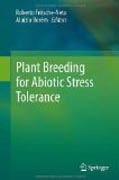
The rapid population growth and the increase in the per capita income, especially in the group of emerging countries referred to as BRIC countries (Brazil,Russia, India, China and South Africa) has created huge pressure for the expansion of the agricultural growing area and the crop yields to meet the rising demand. As a result, many areas that have been considered marginal for growingcrops, due to their low fertility, drought, salinity, and many other abiotic stresses, have now been incorporated in the production system. Additionally, climate change has brought new challenges to agriculture to produce food, feed,fiber and biofuels. To cope with these new challenges, many plant breeding programs have reoriented their breeding scope to stress tolerance in the last years. The authors of this book have collected the most recent advances and discoveries applied to breeding for abiotic stresses in this book, starting with new physiological concepts and breeding methods, and moving on to discuss modern molecular biological approaches geared to the development of improved cultivars tolerant to most sorts of abiotic stress. .Written in an easy to understand style, this book is an excellent reference work for students, scientists andfarmers interested in learning how to breed for abiotic stresses scenarios, presenting the state-of-the-art in plant stresses and allowing the reader to develop a greater understanding of the basic mechanisms of tolerance to abiotic stresses and how to breed for them.
- ISBN: 978-3-642-30552-8
- Editorial: Springer
- Encuadernacion: Cartoné
- Fecha Publicación: 31/07/2012
- Nº Volúmenes: 1
- Idioma: Inglés
